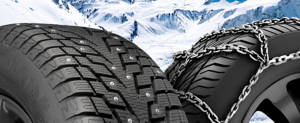When the mercury dips below 45 degrees, you don't want to be left in the cold. Not figuratively, and certainly not literally. That's the temperature we recommend changing from summer or all-season tires to winter tires (or what many folks simply refer to as "snow tires").
But if driving on inches of snow, over ice and through blizzard-force winds, either across the Great Plains or through the reaches of the Rocky Mountains sounds normal, you might have more to consider. Even if that sounds like a regular winter commute in places like Buffalo, Chicago or Detroit.
Whatever the situation might be, you've probably wondered whether it's worth it to get studded winter tires or tire chains on top of the winter tires you're likely already running.
Studded Tires vs. Tire Chains FAQ:
First off, things have to be pretty dicey out for it to be worth using studded tires or tire chains. A good set of normal winter tires can handle mild winter conditions below freezing levels, including sleet and slush. Studded and chained tires are used when there is ice or potentially hazardous snowy roads to contend with (such as mountain passes that are not regularly serviced by snow plows).
If you only have to deal with snow and ice on occasion, we'd recommend using tire chains. In most cases, there will be signs posted like Snow Chains Are Required Beyond This Point.
But if driving in heavy snow and ice is a fact of life, (and if it's getting worse out there by the second) you may be better off investing in studded winter tires. Generally, you can drive faster and safer with them than with chains, and there's no chance of them breaking the same way tire chains can.
While studded tires are mounted onto a wheel and then directly onto a vehicle's axle like any other tire, tire chain installation can get a bit more involved.
Other than the half hour or so it would take to use a jack to lift your vehicle to remove the non-winter tires already on there to replace them with studded winter tires – a changeover service that any America's Tire location can handle for you – it may take many drivers this long just to properly install chains on one tire.
It's best to check your local or state laws before equipping your vehicle with either option, as some states have flat-out banned the use of studded tires, and others impose limits on the use of tires with studs and tire chains during specific months. Generally, these restrictions end around Nov. 1 and carry into spring, or whenever they aren't necessary.
The reason? In a nutshell, studded winter tires and tire chains chew up asphalt and concrete that isn't already covered with snowpack or ice, which can cause millions of dollars in damage to roadways over time.
And outside of this, driving studded or chained tires on a bare roadway will be an extremely uncomfortable experience for both you and your vehicle.
Generally speaking, studded winter tires are going to be safer than tire chains for one reason: they can't break and come flying off while you're already driving, and also can't damage your vehicle.
To take it even further, because they don't break while in use and there's no other installation required, you won't have to stop, safely pull over and potentially risk slipping or otherwise becoming injured while attempting to reinstall tire chains on the side of the road in the middle of winter traffic.
Studded tires (and winter tires in general, if you consistently drive in frigid temperatures but encounter less serious ice and snow) are a great worry-free way to maximize your traction on ice and snow.
But if the snow melts out of nowhere, you're going to have a rugged ride until you can switch back to your normal tires – and you'll want to be sure winter is over for good before you do.
Tire chains are perfect for getting traction with relative immediacy, and can even be removed and stored in your vehicle if the weather clears up.
Conversely, the links can break, damage your vehicle, and can take some time and exertion to install. Also, with tire chains, your speed should never exceed 30 miles per hour (not that you'd want to on hazardous winter roads).
Where to buy winter tires
If you're wondering where to buy winter tires, you're in the exact right spot. We have a wide range of all the best winter tires, including the famed line of Bridgestone Blizzak tires and the legends from the Nordic north: the Nokian Hakkapeliitta line of tires. We can even help you sort out your very own winter tire and wheel package.
Shop winter tiresHave more questions about winter tires? We've got the answers! Read more about tires for ice and snow from our collection of tips and guides dedicated to winter tires, including:
Whether you're hunting fresh winter rubber or a simple winter tire changeover, you can get all your winter tire and wheel needs met at your nearest store. Swing on by any of our America's Tire locations and we'll get you taken care of! Customers who buy and book online save time in-store!
